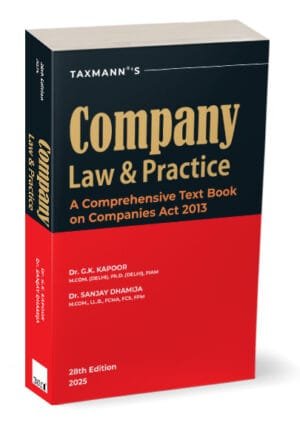Taxmann Fundamentals of Investments By Vanita Tripathi
Taxmann Fundamentals of Investments By Vanita Tripathi
Description
The present book on ‘Fundamentals of Investments’ is written to provide the reader with a comprehensive understanding of the investment environment and investment decision process. It explains the various concepts, tools, and techniques related to investment in financial assets with lively examples and suitable illustrations. This book features a comprehensive discussion of the following concepts:
- Risk and Returns
- Sources and Measurements
- Valuation of Securities
- Approaches to Security Valuation
- Portfolio Analysis
- Selection and Management, including performance evaluation
This book is a comprehensive, up-to-date, illustrated textbook on Investment Management. This book covers the entire syllabus prescribed for students pursuing Undergraduate Courses in Commerce & Management & specifically for the students of B.Com. (Hons.)/B.Com. under CBCS Programme at Delhi University and Other Central Universities throughout India.
The Present Publication is the 6th Edition, authored by Prof. (Dr.) Vanita Tripathi, with the following noteworthy features:
- [Simple, Lucid, Well-knit] presentation of concepts, procedures & techniques of security analysis & portfolio management. Wherever required, the explanation is supplemented by suitable illustrations and examples
- [Learning Outcomes] Every chapter begins with a list of learning outcomes which the reader will achieve after the successful completion of the chapter. It sets the broad framework for the chapter
- [Summary] Each chapter provides summary points to recapitulate the concepts and tools explained in the chapter. It helps the reader to glance over the entire discussion presented in that chapter
- [Solved Problems] Each chapter provides a sufficient number of solved problems for better understanding and application of the concepts explained in the main text
- [Test Yourself] Every chapter provides a variety of assignments to test the reader’s knowledge. It comprises True/False statements, theory questions and numerical problems
- [Project Work] The topic of Investments is lively, and the reader may want to apply various concepts and techniques in real life. For this, “project work” is provided at the end of every chapter. Project work helps the students and other readers of this book to apply various concepts of investments in real life
- [Previous Year’s Question Papers]
- B.Com. (Hons.) 2015 Paper: Fundamentals of Investment
- B.Com. (TYUP) 2016 Paper: Security Analysis & Portfolio Management
- B.Com. (Hons.) 2017 Paper: Fundamentals of Investment
- B.Com. (H)/III/NS 2017 Paper XX: Fundamentals of Investment (C-305)
- B.Com. (Hons.) 2018 Sem. VI: Fundamentals of Investment
- B.Com. 2018 Sem. VI: Fundamentals of Investment
- B.Com. (Hons.) 2019 Sem. VI: Fundamentals of Investment
- B.Com. 2019 Sem VI: Fundamentals of Investment
- B.Com. (Hons.) 2020 Sem. VI: Fundamentals of Investment [OPEN BOOK EXAM]
- B.Com. (Hons.) 2022 Sem VI: Fundamentals of Investment
- B.Com. (Prog.) CBCS 2022 Sem VI: Fundamentals of Investment
The contents of this book are as follows:
- Chapters 1 & 2 discuss the investment environment. The discussion presented in Chapters 1 and 2 revolves around the types of investment alternatives, risk-return trade-offs and structure and trading in the Indian Securities Market. Special attention has been given to the role of SEBI and the prohibition of Insider Trading. Latest developments like Algorithmic Trading and Direct Market Access are also discussed, along with the reforms initiated in the past three decades. The updated information in Chapter 2 is provided
- Chapter 3, Security Analysis, provides at one place the concepts and measurement of various types of returns and risks in financial investment. The reader will have an enriching experience and will have a better understanding of risk and returns concepts which are largely misunderstood
- Chapter 4 comprehensively explains fixed-income securities, various types of fixed-income securities, the valuation of bonds and convertible debentures, and various types of bond yields. Advanced concepts such as Bond Duration and Immunisation have also been discussed
- Chapters 5 to 8 provide various approaches to equity analysis, such as – Fundamental analysis, Technical analysis and Efficient Market Hypothesis, with suitable examples. An attempt has been made to provide the necessary skills and tools for Fundamental Analysis and Technical Analysis. The reader can apply these models and tools, and techniques in real-life decisions. Equity valuation models have also been explained with suitable illustrations
- Chapters 9 & 10 deal with portfolio management & portfolio analysis, portfolio construction and portfolio selection. The capital market theory is also elaborated. Further, these provide a detailed explanation of CAPM (Capital Asset Pricing Model), the most popular model of asset pricing in finance, as well as an explanation of the need and measure of portfolio performance evaluation such as Sharpe index, Treynor’s Index and Jensen’s alpha
- Chapters 11 & 12 explain Financial Derivatives and Investor Protection in India
| bookauthor | Vanita Tripathi |
|---|---|
| edition | 6th Edition 2023 |
| hsn | 49011010 |
| isbn | 9789356225848 |
| language | English |
| binding | Paper back |
Related products
Original price was: ₹645.₹515Current price is: ₹515.













